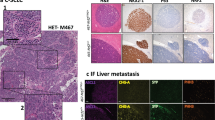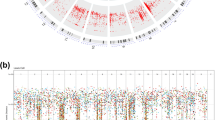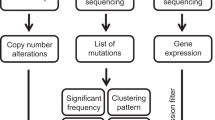Abstract
The existence of tumor-suppressor genes was originally demonstrated by functional complementation through whole-cell and microcell fusion1,2. Transfer of chromosome 11 into a human non-small-cell lung cancer (NSCLC) cell line, A549, suppresses tumorigenicity3. Loss of heterozygosity (LOH) on the long arm of chromosome 11 has been reported in NSCLC and other cancers4,5,6. Several independent studies indicate that multiple tumor-suppressor genes are found in this region, including the gene PPP2R1B at 11q23–24 (ref. 7). Linkage studies of NSCLC are precluded because no hereditary forms are known8,9. We previously identified a region of 700 kb on 11q23.2 that completely suppresses tumorigenicity of A549 human NSCLC cells10. Most of this tumor-suppressor activity localizes to a 100-kb segment by functional complementation. Here we report that this region contains a single confirmed gene, TSLC1, whose expression is reduced or absent in A549 and several other NSCLC, hepatocellular carcinoma (HCC) and pancreatic cancer (PaC) cell lines. TSLC1 expression or suppression is correlated with promoter methylation state in these cell lines. Restoration of TSLC1 expression to normal or higher levels suppresses tumor formation by A549 cells in nude mice. Only 2 inactivating mutations of TSLC1 were discovered in 161 tumors and tumor cell lines, both among the 20 primary tumors with LOH for 11q23.2. Promoter methylation was observed in 15 of the other 18 primary NSCLC, HCC and PaC tumors with LOH for 11q23.2. Thus, attenuation of TSLC1 expression occurred in 85% of primary tumors with LOH. Hypermethylation of the TSLC1 promoter would seem to represent the 'second hit' in NSCLC with LOH.
This is a preview of subscription content, access via your institution
Access options
Subscribe to this journal
Receive 12 print issues and online access
$209.00 per year
only $17.42 per issue
Buy this article
- Purchase on Springer Link
- Instant access to full article PDF
Prices may be subject to local taxes which are calculated during checkout





Similar content being viewed by others
References
Harris, H., Miller, O.J., Klein, G., Worst, P. & Tachibana, T. Suppression of malignancy by cell fusion. Nature 223, 363–368 (1969).
Weissman, B.E. et al. Introduction of a normal human chromosome 11 into a Wilms' tumor cell line controls its tumorigenic expression. Science 236, 175–180 (1987).
Satoh, H. et al. Suppression of tumorigenicity of A549 lung adenocarcinoma cells by human chromosomes 3 and 11 introduced via microcell-mediated chromosome transfer. Mol. Carcinog. 7, 157–164 (1993).
Iizuka, M. et al. Allelic losses in human chromosome 11 in lung cancers. Genes Chromosomes Cancer 13, 40–46 (1995).
Rasio, D. et al. Loss of heterozygosity at chromosome 11q in lung adenocarcinoma: identification of three independent regions. Cancer Res. 55, 3988–3991 (1995).
Wang, S.S., Virmani, A., Gazdar, A.F., Minna, J.D. & Evans, G.A. Refined mapping of two regions of loss of heterozygosity on chromosome band 11q23 in lung cancer. Genes Chromosomes Cancer 25, 154–159 (1999).
Wang, S.S. et al. Alterations of the PPP2R1B gene in human lung and colon cancer. Science 282, 284–287 (1998).
Murakami, Y.S., Brothman, A.R., Leach, R.J. & White, R.L. Suppression of malignant phenotype in a human prostate cancer cell line by fragments of normal chromosomal region 17q. Cancer Res. 55, 3389–3394 (1995).
Thiagalingam, S. et al. Evaluation of candidate tumour suppressor genes on chromosome 18 in colorectal cancers. Nature Genet. 13, 343–346 (1996).
Murakami, Y. et al. Localization of tumor suppressor activity important in non small cell lung carcinoma on chromosome 11q. Proc. Natl. Acad. Sci. USA 95, 8153–8158 (1998).
Gomyo, H. et al. A 2-Mb sequence-ready contig map and a novel immunoglobulin superfamily gene IGSF4 in the LOH region of chromosome 11q23.2. Genomics 62, 139–146 (1999).
Fogh, J., Fogh, J.M. & Orfeo, T. One hundred and twenty-seven cultured human tumor cell lines producing tumors in nude mice. J. Natl. Cancer Inst. 59, 221–226 (1977).
Santon, J.B. et al. Effects of epidermal growth factor receptor concentration on tumorigenicity of A431 cells in nude mice. Cancer Res. 46, 4701–4705 (1986).
Ohsaki, Y., Ishida, S., Fujikane, T. & Kikuchi, K. Pentoxifylline potentiates the antitumor effect of cisplatin and etoposide on human lung cancer cell lines. Oncology 53, 327–333 (1996).
Aoe, K. et al. Effect of docetaxel with cisplatin or vinorelbine on lung cancer cell lines. Anticancer Res. 19, 291–299 (1999).
Yamori, T., Sato, S., Chikazawa, H. & Kadota, T. Anti-tumor efficacy of paclitaxel against human lung cancer xenografts. Jpn. J. Cancer Res. 88, 1205–1210 (1997).
Hirai, K., Shimada, H., Ogawa, T. & Taji, S. The spread of human lung cancer cells on collagens and its inhibition by type III collagen. Clin. Exp. Metastasis 9, 517–527 (1991).
Sakai, T. et al. Allele-specific hypermethylation of the retinoblastoma tumor-suppressor gene. Am. J. Hum. Genet. 48, 880–888 (1991).
Merlo, A. et al. 5′ CpG island methylation is associated with transcriptional silencing of the tumour suppressor p16/CDKN2/MTS1 in human cancers. Nature Med. 1, 686–692 (1995).
Kane, M.F. et al. Methylation of the hMLH1 promoter correlates with lack of expression of hMLH1 in sporadic colon tumors and mismatch repair-defective human tumor cell lines. Cancer Res. 57, 808–811 (1997).
Schutte, M. et al. Abrogation of the Rb/p16 tumor-suppressive pathway in virtually all pancreatic carcinomas. Cancer Res. 57, 3126–3130 (1997).
Kanamori, M. et al. Microsatellite instability and the PTEN1 gene mutation in a subset of early onset gliomas carrying germline mutation or promoter methylation of the hMLH1 gene. Oncogene 19, 1564–1571 (2000).
Ihde, D.C. & Minna, J.D. Non-small cell lung cancer. Part I: Biology, diagnosis, and staging. Curr. Probl. Cancer 15, 61–104 (1991).
Murakami, Y. & Sekiya, T. Accumulation of genetic alterations and their significance in each primary human cancer and cell line. Mutat. Res. 400, 421–437 (1998).
Ghosh, K. & Ghosh, H.P. Role of the membrane anchoring and cytoplasmic domains in intracellular transport and localization of viral glycoproteins. Biochem. Cell Biol. 77, 165–178 (1999).
Orita, M., Suzuki, Y., Sekiya, T. & Hayashi, K. Rapid and sensitive detection of point mutations and DNA polymorphisms using the polymerase chain reaction. Genomics 5, 874–879 (1989).
Kukita, Y., Tahira, T., Sommer, S.S. & Hayashi, K. SSCP analysis of long DNA fragments in low pH gel. Hum. Mutat. 10, 400–407 (1997).
Frommer, M. et al. A genomic sequencing protocol that yields a positive display of 5-methylcytosine residues in individual DNA strands. Proc. Natl. Acad. Sci. USA 89, 1827–1831 (1992).
Veigl, M.L. et al. Biallelic inactivation of hMLH1 by epigenetic gene silencing, a novel mechanism causing human MSI cancers. Proc. Natl. Acad. Sci. USA 95, 8698–8702 (1998).
Acknowledgements
We thank R.L. White and M. Meuth for discussions, and K. Ghosh, M. Sakamoto, K. Kumada, H. Sakamoto, S. Koizume, T. Fukami and M. Watanabe for materials and technical assistance. This work was supported in part by a Grant-in-Aid for the Second Comprehensive 10-Year Strategy for Cancer Control from the Ministry of Health and Welfare, Japan; a Grant-in-Aid for Special Projects for Cancer Research from the Ministry of Education, Science, Sports and Culture of Japan; a Grant from the Promotion of Fundamental Studies in Health Sciences of the Organization for Pharmaceutical Safety and Research (OPSR) of Japan; and U.S. Public Health Service award HD-24605 (R.H.R.). M.K., H.F., T.N. and T.K. are recipients of Research Resident Fellowships from the Foundation for Promotion of Cancer Research of Japan.
Author information
Authors and Affiliations
Corresponding author
Rights and permissions
About this article
Cite this article
Kuramochi, M., Fukuhara, H., Nobukuni, T. et al. TSLC1 is a tumor-suppressor gene in human non-small-cell lung cancer. Nat Genet 27, 427–430 (2001). https://doi.org/10.1038/86934
Received:
Accepted:
Issue Date:
DOI: https://doi.org/10.1038/86934
This article is cited by
-
SynCAMs in Normal Vertebrate Neural Development and Neuropsychiatric Disorders: from the Perspective of the OCAs
Molecular Neurobiology (2024)
-
CADM1 impairs the effect of miR-1246 on promoting cell cycle progression in chemo-resistant leukemia cells
BMC Cancer (2023)
-
Cell adhesion molecule 1 expression in mycosis fungoides versus parapsoriasis versus inflammatory dermatosis: an immunohistochemical comparative study
Archives of Dermatological Research (2023)
-
Demethylation of CADM1 and SOCS1 using capsaicin in cervical cancer cell line
Naunyn-Schmiedeberg's Archives of Pharmacology (2023)
-
Somatic mutations of CADM1 in aldosterone-producing adenomas and gap junction-dependent regulation of aldosterone production
Nature Genetics (2023)



